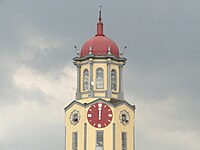9th Century onward
| Part of the series on the |
| History of Manila |
|---|
 |
| History |
|
| Events |
|
| Other |
- c. 900 CE - The Kingdom of Tondo was at its peak and was a center of commerce and trade of the Tagalogs. It was during this era that the King of Tondo issued the Laguna Copperplate Inscription to Namwaran's clan on 21 April 900 CE.[1]: "134" [2]: "38"
- c. 1175 - the Polity of Namayan was established by the Tagalog people at the Pasig River. It was led by the house of Lakan Tagkan during its peak in the 1100's.[3]
- c. 13th Century - the Kota Seludong or better known as the Kingdom of Maynila was founded by Avirjirkaya which spanned present day Intramuros.
- c.1300- Empress Sasaban became the Queen Regent of Namayan. According to oral tradition, she was a concubine of Anka Widyaya of Java and bore a child named Prince Balagtas[4]
- 1365 - The Battle of Manila (1365). The forces from the Kingdoms of Luzon fought against the Empire of Majapahit from Java in what is now Manila.
- Uncertain timestamp - the Tagalog and Kapampangan-fortified city of Cainta was established on an upriver area which occupied the shores on both sides of a waterway of the Pasig River. It was located not far from where the Pasig River meets the Lake of Ba-i.[5]
- 1450 - Dayang Kalangitan became the Hara (Queen who is a wife of a Rajah) of Tondo. She established her dwelling in the banks of the Bitukang Manok River (present day Parian Creek) in Pasig.
- 1480 - Rajah Aki Matanda became the Rajah of Manila.
- 1500 - Salalaia became the Rajah of old Manila.[6]
- 1521 - Sri Bunao became the Lakandula based in Tondo.
